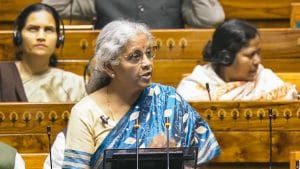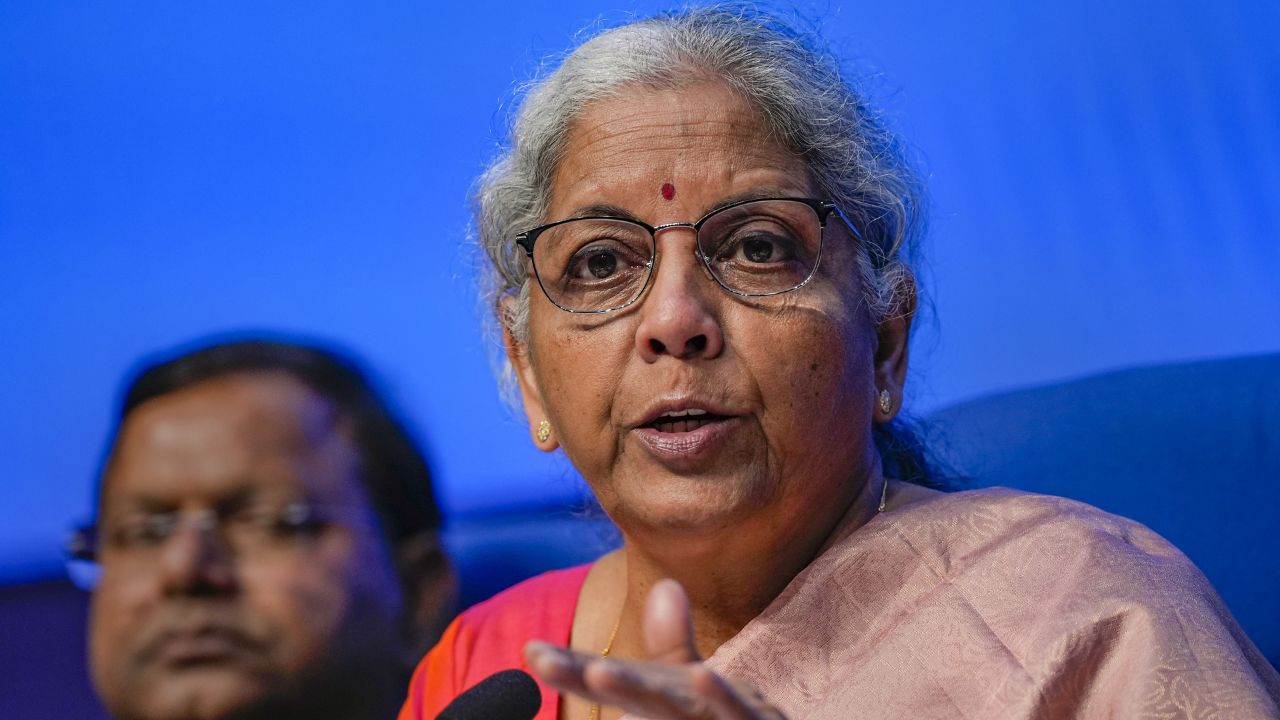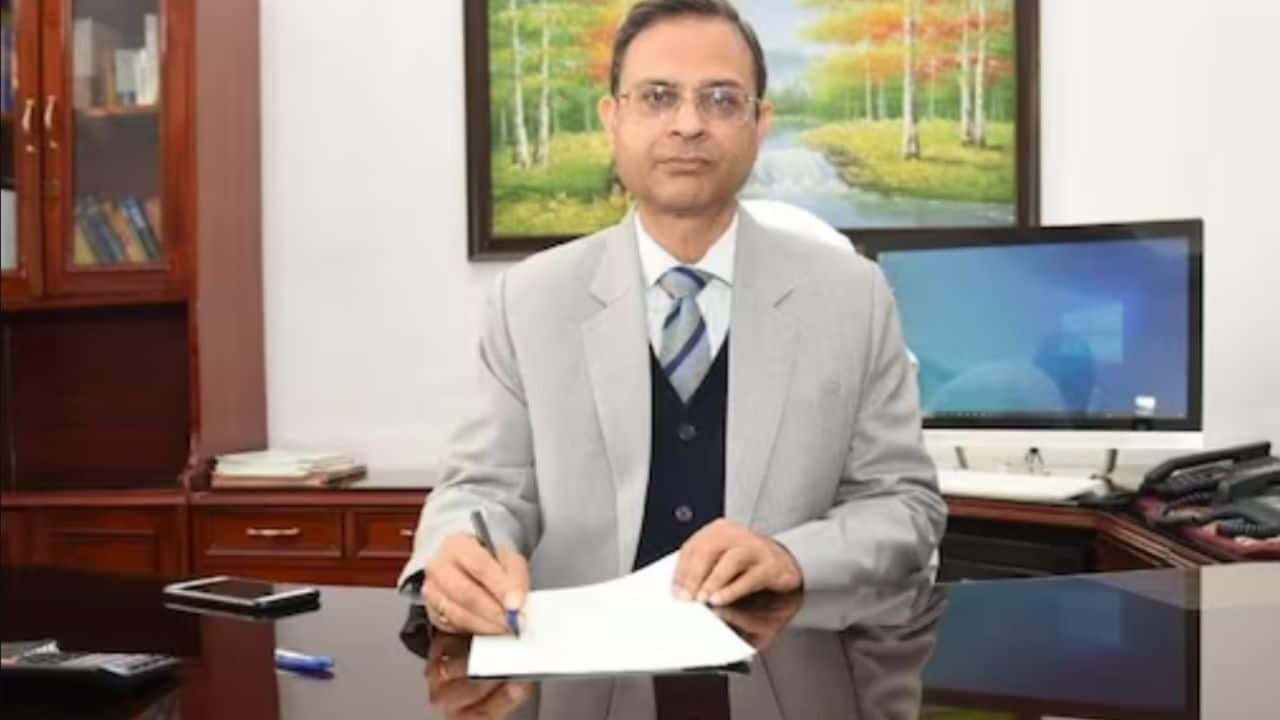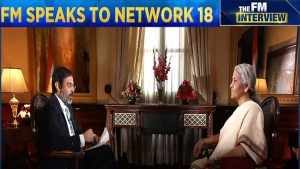Exclusive | Govt confident of managing inflation, keeping robustness of growth intact: FM Sitharaman

KV Prasad Jun 13, 2022, 06:35 AM IST (Published)
 Listen to the Article (6 Minutes)
Listen to the Article (6 Minutes)
Summary
Finance Minister Nirmala Sitharaman says the government has worked diligently to address both growth-promoting factors and inclusivity initiatives, ensuring that everyone can participate in and benefit from this growth process. Read the full transcript of her exclusive interview with Network18’s Editor-in-Chief Rahul Joshi.
We are confident that we can effectively manage inflation while ensuring robust growth. We have worked diligently to address both growth-promoting factors and inclusivity initiatives, ensuring that everyone can participate in and benefit from this growth process, said Finance Minister Nirmala Sitharaman in an exclusive interview with Network18’s Editor-in-Chief Rahul Joshi, a day after presenting Budget 2024.
“The Chief Economic Adviser has also commented, in his preface he has elaborated on how 7% is not difficult to achieve. Globally, also, the various organisations which look at economies of all countries, like International Monetary Fund (IMF), for instance, has also enhanced their own assessment. So upgrading our growth estimates is not just singularly our business, people are seeing that fundamentally a lot of activities are happening,” she noted.
Below is the verbatim transcript of the interview:
Q: No sops, no populist measures, even in 2019 Interim Budget, the government had announced some sops, like tax rebates, there were some announcements for the farmers. But none this time. Seems like a very confident Prime Minister Narendra Modi going into 2024 elections. You’ve never looked more relaxed to me before. What was going on in your mind while drafting this?
A: Thank you for having me after the Budget, like every year. It’s a great opportunity to talk to your viewers and also for others who are watching this programme more with the keenness to know about the Indian economy.
Yes, the Budget yesterday did not have any sops announced. We treated it like a true vote on account, an Interim Budget before an election. And also an Interim Budget, which has been presented with the clear understanding that several programmes, which were launched with empowerment of citizens in mind, over the last 10 years are reaching the ground, and the beneficiaries are already on their own speaking about it. The power of word of mouth is very strong. So when a beneficiary gets truly the benefit, and without any middlemen playing a role in it, they really understand that the intent of the government is what they’ve said is what is getting executed.
Also Read: Exclusive | Highlights of the interview with India’s Finance Minister post-budget 2024
So I place a lot of trust in the word of mouth, which has helped in schemes like Ujjwala, Pradhan Mantri Awas Yojana (PM Awas), PM Mudra Yojana, PM Street Vendor s AtmaNirbhar Nidhi (PM SVANidhi) Yojana, all of which have benefited the small households, small people who want to do their business, and who don’t have money to give for collateral, no properties to give.
So this government has actually, because of the vision with which Prime Minister is committed to serve this country, is actually serving the common people in letter and spirit. And that is recognised by the people themselves. It’s not as if you’re saying and you’re showing target numbers, you’re showing achievement numbers, no. The people on the ground are saying about it, I’ve got it, and so is the neighbor, so is the neighbor of that household and so on.
That is why I have used an expression and I mean it when I said it, that this is secularism in action. This is where we have not shown any difference between members belonging to this community or that community, this religion or that religion, or somebody is relative and not relative, no difference. The project reaches the ground for everybody who deserves to get it. And if they are eligible, they get it irrespective of who they are. And therefore, in every way, the principle empowerment, the Sabka Saath Sabka Vishwas Sabka Vikas has been executed everywhere, and that has the sense of confidence, that the blessings of the people are not just at the time when we give promises but the blessings are even now coming in abundantly to say yes, you’ve kept up your word.
Q: You have steered the economy in difficult times. If I look at your last five years, there’s been the pandemic, right now two wars are going on. Even then we are projected to grow at 7.3%. Now, if I were to look at the non-nominal GDP, which has grown only 10.5%, consider an inflation of 4-4.50% do you think that 7% itself would be challenging? I mean, do you think it is realistic for us to grow on those lines?
A: The Chief Economic Adviser has also commented, in his preface he has elaborated on how 7% is not difficult to achieve. Globally, also, the various organisations which look at economies of all countries, like International Monetary Fund (IMF), for instance, has also enhanced their own assessment. So upgrading our growth estimates is not just singularly our business, people are seeing that fundamentally a lot of activities are happening. The robustness of the economy has not slackened anywhere, it has maintained its, the buoyancy with which things are happening, not just revenue collection when I am talking of buoyancy. So there is reason to believe, yes, it is possible.
And the deflator not just the inflation, but the deflator itself is constantly, meaning we are looking at controlling inflation, the other factors fall in place so the deflator itself then plays a role and therefore, we are confident that on the one hand, we will be able to manage inflation and on the other to keep the robustness and growth so that it is sustained growth. We have made every effort to look at both growth driving elements and inclusivity driving elements so that nobody is left out from this growth process, both to contribute and to gain from it.
Q: Something that has been commented enough and you have got a lot of accolades for it in this Budget. If you look at the fiscal glide path, I think you have beaten estimates. This year you have projected 5.1 next year so that also looks promising. What is your message to the sovereign rating agencies, you are expecting an upgrade?
A: Well, I would think that they do their job, but periodically, it’s our business also to bring it to their notice that economy, particularly emerging market economy like India, despite the odds we are doing a lot of reforms, systemic reforms, which actually you are seeing is bearing the results now. If only Prime Minister Modi hadn’t pressed the pedal, let us say the accelerator during COVID, even as we are managing COVID, we will have to attend to reforms and continue doing the reforms. The Aatmanirbhar Bharat announcements were all infused with so much of reform measures. Otherwise, we wouldn’t have eliminated more than 68,000 rules, which were becoming instruments for rent seeking people. So systemic reforms have continued whether it was pre-COVID, GST and IBC together with very many other reforms like professionalising public sector banks and so on. The emphasis on reform has given us adequate rewards and we will continue doing that.
That is why even in the budget, we have emphasised on transparency, we have emphasised on getting everything on board the Budget process itself rather than keeping it outside of the Budget or underneath the carpet. These are not small steps, and that has been consistently done in the last four five years and before that, as I said IBC or banking reforms. So, to list it, there are so many; some small, some very big.
Also Read: Exclusive | Finance Minister Nirmala Sitharaman defends ambitious capex, decodes food inflation
The small ones are having very big implication in making the economy much more cleaner and open and transparent. The bigger ones which are bearing results in terms of the money that you collect in goods and services tax (GST), these are not small steps. So, that is the one which I would play as important indicators, which rating agencies should look at comprehensively rather than look at just one detail here, one detail there. Macroeconomic stability is also very well kept up.
Q: Glad you mentioned reforms, I think big message coming from you that the government will continue on the road for reforms. I have said this to you before that cutting the rich tax last year, in an election year before that cutting the corporate rate tax. I mean, you have taken some bold measures. What is the next level of reforms that we can expect from you broadly, I mean directionally?
A: First of all, as I said, the system to become more transparent, more things will have to be done, in order to make sure that we work together with states, it’s one thing for the Union government to work on those areas, which are exclusively with the central government. But where there are overlaps; there are some states which have come about enthusiastically to say, yes, we should benefit also from this vibrancy which results after such measures are taken. And therefore, when reforms are talked about, we normally always say, three levels, where it has to be carried out with the same vigour, the central government, the state government, and then the local bodies. Now working with the State governments has already started happening. The last few years, you will see very many areas where we are working together. The local body level, the municipal urban local bodies, the panchayats, we need to have greater interchange of ideas and working together with them also, that will also continue now.
Q: Finance Minister if I were to ask you this one question – with the exception of Air India, no strategic privatisation has taken place any significant, whether it has IDBI, CONCOR, SCI, banks. Why has your government sort of repeatedly kind of underperformed on this disinvestment aspect? I mean, is the thinking changing within the government? Are you looking at sort of strategic sales and not maybe offer to sell completely? Is there some shift in the thinking?
A: I would want you to, first of all, put that question into the frame that I have laid in the matter of public sector enterprises policy. If a policy framework has been announced, and in that we have said that there are only core strategic sectors which government recognises where the government will be having a minimal presence, and even in those sectors, private sector will be allowed to or it will be completely open for them to participate in total, in the sense there will not be any one sector, inclusive of the core strategic sector, which will be exclusively reserved for public sector, whereby consolidation will have to happen to make them big enough for a big country like India, efficiencies will have to be brought in, their the values will have to be increased. So, this question of yours, will have to fit into that frame. I will not reverse any of the Cabinet approved decisions. But at the same time, you should probably also have noticed that for each of them, we are working to make sure — we are not allowing them to remain there till they are getting disinvested. Equally, we are working to make sure that their valuations are kept up, they are improved upon that if you look at the public sector listing listed companies and their valuation in the market today, you see the kind of vibrancy which has been brought in into them, their share values have gone up, the dividends are even much better than earlier. Absolutely. So, disinvestment is one thing, but in bringing value to them, and make sure that the markets look at them absolutely. favourably.
Q: In fact, the public sector companies have done really well and public markets are also where they are. Would you consider sort of diluting your stake, maybe to 49%, in some of the companies, thereby they are not government owned but at the same time you have best of both the worlds and the valuations could go up even further.
A: Certainly, that is not something which has been denied earlier, meaning as a matter of policy, but in many ways, we are already you will see periodically, the Department of Investment and Public Asset Management (DIPAM) which takes care of the disinvestment has, slowly, in trickles, released a lot of government’s shares into the market so that private ownerships can come in and they can take hold of those shares. So that is happening already. And we would certainly like to make sure there is greater participation.
Q: ….in companies like State Bank of India (SBI) or Oil and Natural Gas Corporation (ONGC), this could be another possibility?
A: Absolutely.
Q: One of the big ideas with this Budget which struck to everyone as a big idea has been the announcement of a corpus of ?1 lakh crore to provide interest free or low interest sort of loans for research and innovation. Can you elabourate a little bit on this? How will this work? Will there be a separate sort of entity managing this? How will it go forward?
A: Yes, certainly. I first would bring in a bit of a context to this. It’s not as if we’re doing it now for the first time. Earlier too there were several funds within different departments like the science and technology, CSIR, funds were all over the place. You had them doing supportive activities for innovation, each from their own side. Two years ago, I remember announcing the National Research Foundation, which brought together all these thinly spread resources to one pool. And from there, each of the department would claim whatever they would want to fund in terms of innovation supportive activities. But what we’ve now done is they may remain so, but the government would now bring in a kind of an institution or a vehicle, which can take this ?1 lakh crore, which will be given to them next few years in total, as interest free corpus amount. Using that, they can then identify innovation related exercises, which are happening in the private sector, and fund them. I may give this interest free 50 year loan to the corpus, but the managers of that fund will then decide to whom, at what cost should they give it. The cost may vary depending on the risk factors and the judgment of the professionals who will manage it. But it’s certainly a fund from where private innovation will be supported.
Q: I’m sure you’ll be asked this question in future but the allocation for capex at ₹11.1 lakh crore – does it seem like a lofty goal considering that you could not even do ₹10 lakh crore in this year?
A: No, but not really – I mean, we have done only ₹2-3 lakh crore, that’s not the case. We are closer to ₹10 lakh crore. It’s also because absorption has its own limits, whether it’s the states or the departments within government of India, when the capital expenditure is undertaken through the outlays given to them, it is only that much within 12 months that they can do and not beyond.
So, sometimes reaching the target, however ambitious it is, is to the last mile difficult within 12 months. Had we given them a few more months, they will probably even complete that. But the condition for these capital expenditure, which I have announced since last two-three years is that that amount should be utilized within the year.
So many of the state governments, which take the money, which are very good in implementing – in fact I find states very enthusiastic in wanting to avail of this facility. The difficulty comes that if you restrict them to using it within 12 months, and which is what we aim it, we want them to use it within 12 months. So I’m not saying restrict in that sense, but within 12 months, when you expect it to spend that money, there are times when completely utilizing it becomes difficult. They partly use this. That is why ₹10 lakh crore, you might reach ₹9-9.2 lakh crore and not touch ₹10 lakh crore. But achieving ₹9.2 lakh crore Within a matter of 12 months is I think good enough. So to increase it to ₹11 lakh crore, I’m very hopeful, it will definitely get used. And the amounts, which are being given to states are also having high utilization.
Q: If I’m right, we get a sense that there is an indication of tapering of government spending. We’ve discussed this in our last interview as well. You expect private sector also now to do some heavy lifting. So, we are seeing some of the sectors looking up now, there are investments in steel aviation, power, machinery – but are you happy with the level of private sector participation? You said that they’re like Hanuman and Hanuman has no idea of his own power. When do you think that this Hanuman will lift the economy mountain?
A: I think as you said they are coming out, there is investment happening, the production linked incentive (PLI) scheme is also helping them. So investments in newer areas do have a slightly longer gestation period. It’s not as if the brownfield projects are getting additional money – that also is happening. But the interest in the sunrise sector is really obvious now. People are taking a lot of interest and you’re seeing them coming forward.
Q: One more question on the stress that is being seen in the rural economy. Your higher allocation outlet to MGNREGA also is an indication, betrays the stress on rural economy. If you look at the results of FMCG companies, consumer durable companies, even if you look at the Nielsen data, it shows that the rural volume growth has underperformed urban volume growth for almost seven quarters now in a row. So what is your prognosis of rural demand and how do you think we will deal with this going forward?
A: I am not sure if I will be able to describe how I view what is happening in the rural areas. Let us recognise that there is a lot of shift in the way employment is panning out. Let us recognise that migration is now looking at redefining itself in a way. Many people who went back to their villages with some skills acquired are wondering if they can continue being there and utilising and benefiting from the skills that they have acquired. Industries too today are a loving a lot of work from home, and many who are avoiding travelling are also staying back. So that shift will have to be recognised, but equally that’s not to say people are staying back home without work or staying back and working from there with large companies being established everywhere else. So, there is a transition happening, undoubtedly.
Second, there is also this little savings, which is coming through which we are seeing from the various fixed deposits which are growing as different from small savings. You are also seeing some middle-class looking at savings through the stock markets, the demat accounts and so on. So, the indicators with which we are looking at the rural economy may vary and there are very many newer indicators which we may not want to miss out on.
Also Read: Exclusive | Finance Minister Nirmala Sitharaman defends ambitious capex, decodes food inflation
Yes, I agree fast moving consumer goods (FMCG) market will also tell us that durable consumables are not being consumed as much as before, but well, I take that as one indicator. But equally, the kind of activities which are now happening in the rural areas, because of better connectivity, because of other digitisation are also yet to be measured I would think.
Q: One thing related to the job market, especially, if you look at the campus recruitment in engineering colleges and MBA colleges, so on one side, the economy is doing well, and all indicators point to that. But on the other hand the campus recruitment this year has been muted, salaries have been lower, many students have not got a job offer yet. How do you see this in relation to the overall big picture?
A: The question about employment, I am afraid we are repeatedly focusing only on those indicators pertaining to the formal economy, which is important, I am not denying its role. So college recruitments, IIM like campuses are important, but equally, the jobs that are getting created in the middle and lower order are not getting counted at all. I would look at the way in which banks and their credit off take is happening in small and medium businesses, the new companies which have got registered, which is a data which I put out from them, see the number of new companies which have started, are certainly not people who are being recruited for jobs. They are people who are investing money, believing in their skills, registering a company and probably giving jobs for others.
Why would new companies get registered in a bigger number than before, if employment is not being offered. Companies cannot operate in a vacuum, without human beings in them. So I think a fairer, open and an exhaustive picture of India’s employment, both in the formal and non-formal areas will have to have some kind of wider base with which and we need to bring in such data so that the discussion can be more informed.
Q: And some of the global slowdown is also having an impact in our jobs especially at the higher end, right? IIM campuses or engineering colleges etc.
A: Equally – because of the way in which artificial intelligence is coming, the kind of job requirements that are expected of new recruits are also changing. So the people with old skill sets are now expected to have additional newer skill sets for entering into a certain area, which till now did not exist. So we are certain lots of calibrations are required in understanding this.
Q: Yesterday in your Budget speech, you were very appreciative of income taxpayers. In fact, the number of people paying income tax has gone up, collections are up 2.4 times, you were quite appreciative. In fact, I thought you just stopped short of sort of giving them something back because it was a vote on account. My question is that salaried people are paying 30% today, whereas corporates pay 22% tax in the longer term …
A: Corporates meaning as an entity.
Q: Yes, that’s right. So I’m saying in the longer term directionally, do you think you would align this in some way or the other? I’m talking about the longer term.
A: The direct taxation reforms are a steady job in the pipeline, and some results come out and more work is happening. So direct taxation is something on which the ease of the taxpayers’ facilitation has to be improved. And also, one of the things happened yesterday, one of the serving the customer better business in the taxation regime happened yesterday, but more work can always be done.
Q: So salaried can be more hopeful in the coming days, in July budget?
A: I am not saying anything now.
Q: You managed inflation very well in the past few years. What about food inflation? That’s really pinching the common man, pulses are up 20%, vegetables 27%, any plan to sort of rein in food inflation?
A: Food inflation cannot be spoken as one basket or one item. It has so many different components, if pulses are becoming more expensive, we are import dependent to meet adequacy in meeting their demand. In the sense, we are not self-sufficient, we need to import to meet our demand. And when you depend on imports, the prices are determined by the supplier not by us.
So when it is pulse or dal, where the prices have to be controlled, so much has to be done well in advance. If you know your crop is only X and not what you need, then you preplan imports, you have to touch on very many countries to get the imports and so on. And in that, of course, the role of the traders is very important. That is one thing.
Second is you’re looking at other seasonal vegetables, which can equally be affected by drought or by excess rain. No import in the last minute can help us if suddenly one particular crop, say of potatoes or onions or tomatoes, are lost. The last minute procurement from somewhere else is also fraught with difficulties. So the treatment for controlling price for pulses and the perishable crops, and let’s say rice, which can be stored are all very different.
And that is why there is a committee in government of India, which looks into this and makes sure that periodically, you’re able to get in time those based on estimates. It’s an ongoing job. It’s not with a deadline. It has to keep happening. And I think largely the committee has been successful otherwise we couldn’t have been closer to the policy range.
Q: I had interviewed the Prime Minister in 2016, as early as that, and he spoke about the white paper. He said that we should come out with the white paper because we inherited an economy which was in the fragile five. And that was early, just two years into the government, and what we had to do to drag it out of the levels it had reached. You spoke similarly yesterday about the white paper, and you said it was a herculean task to bring the economy back from the brink? What is the idea behind the white paper? Why now? And will it be another stick to beat the opposition with?
A: You are right in pointing out that honourable Prime Minister has spoken about it even in 2016 in your interview, then it was so many different sections of our society themselves, suggested to us that you better bring a paper out, white paper out to say why Indian economy has reached the fragile five, to say why a bank set become such a blackhole, nothing could be restored of the banks, banks were all in deep trouble. Look at the number of NPAs and the value of the NPAs, meaning what was the original value and to what extent they had reached almost close to valueless positions. So, whether it was your banks, whether it was the overall economy, whether it was defence procurement, whether it was a vital sector of telecom, why even minerals, every area was ridden with problems.
Now, if you are talking of corruption, well, it’s one thing, it goes to the court, people get punished and then the money is given back or not given back, values are retrieved or not retrieved – that is one side of the story. But what impact it left on the economy to restore your banks back to health, to make sure your country is safe with adequate strategic equipments given to defence personnel, to make sure that your minds which are well under the earth, meaning inside the earth, under the soil, to use them for the benefit of the country rather than to use them as one instrument through which you line your own pocket. What implications it had on the economy. Banks not being healthy, mines being given to brothers and sisters, who did not want to extract the mineral for the benefit of the country. Spectrum allocations, if it had happened in time, I didn’t have to spend so much to restore BSNL to have 2G or 4G in time and what implication does it have on the country when 4G is not available in time whereas the whole world is talking about 5G.
So, the kind of impact that it had, the mismanagement, it is not just talking about policy paralysis for a fragile five, it’s talking about every one of these steps, which one, morally was immoral, in the sense was not right and equally the kind of positive effect if it had happened very well in a transparent fashion, it would have had on the economy. We lost 10 glorious years, and to restore it to that position back and then to pull it up. To now get closer to the world’s third largest economy is a Herculean task, which I am grateful this country had a Prime Minister like Modiji, who single-mindedly said I will restore this economy back, it is my service to the nation. Otherwise, it wouldn’t have happened. So why the white paper now? We have had 10 years and prior to that there was 10 years where you saw all this happen – policy paralysis, corruption, nation losing its endowments, and so on. Ten years under Prime Minister Modi, what kind of course correction set to happen; what kind of restoring confidence had to happen; what kind of pulling back from rut that had to happen; And equally, making sure you are purchasing the equipment, you are removing BSNL from distress, you are making sure BSNL employees are given their due. You are making sure the country gets 5G, not just 4G. Look at the coverage India has in 5G today.
Also Read: Budget 2024: FM Sitharaman on India’s ‘GDP’, 3 consecutive years of 7% growth
All this and to make sure that the investor confidence is not just intact but is growing that within a matter of 8 years, I would say we have reached $596 billion as our foreign exchange reserve. Just compare that with the last 10 years, at least for the sake of the elected honourable representatives who are sitting in the Parliament, they should know, what was it then, what effort it took to restore it here and what we should not therefore ever imagine, or dream of doing in personal interest, forgetting the nation. Why now? Parliament should know. Two, at that time had Prime Minister Modi not taken the call, that in the interest of our nation, I would not bring it out. He didn’t bring the White Paper then because you put the nation first. You say, if I do it now, I can be happy. But the confidence in our country would have been lost, investors wouldn’t have come, our own people would have lost faith in the systems. They would say, this government will come, eat away and go, then next government can come, it will do its own, but we are all languishing. The faith in institutions, in government, in leaders, in politics would have been lost in the minds of people. And I am so grateful that the Prime Minister didn’t do it then. He restored it all. Put India on such a wonderful track towards becoming third largest economy and then so that all of us know what it took and what we should not do in the future is this paper.
Q: So, when do you table it?
A: Soon.
Q: When it comes to the markets, Nirmala Sitharaman can do no wrong. Last two-three years markets have been on a roll. My question is, can you assure the markets and its participants that there will be stability in the capital gains tax regime – and I ask this question because last year you had tweaked the debt mutual funds in your budget speech? So, is there stability around the corner in the foreseeable future?
A: Policy stability is one thing which Prime Minister really lays a lot of emphasis on. He doesn’t like periodic tweaking. He would tell you it is only two years, it’s only three years, let it play out, let it settle down and so on. So, he is never in favour of quick twists and turns. And this is not me saying people who have observed him for his tenure as chief minister will know that the biggest strength under Prime Minister Modi is stability and policy. So that is a single line reply that I can give you.
Q: Reserve Bank of India (RBI) has imposed restrictions on the operations of Paytm Payments Bank. What is your message to the fintech industry? Is there more than meets the eye in this case or are we going to be cautious when it comes to the fintech sector?
A: I wouldn’t want to come comment on any one particular company. But fintech is an area in which all of us are very enthusiastic. India has contributed a lot in the sector. India’s contribution in the sector has been globally recognised. Today, if people are looking at solutions, fintech solutions, they are looking to India. Our youth have contributed a lot and built capacities for themselves. This is an area which we certainly like to work with and encourage. I am not commenting on any one company.
Q: You have been tightening things around, would you think that the RBI should loosen now?
A: Well RBI does take its own call, but I will appreciate the RBI for working together with the stakeholders and I am sure they take a call that keeping growth in mind, they have been steady, I suppose. They will continue to be steady is my expectation and hope.
Q: We are seeing a different side of Nirmala Sitharaman. In the last few weeks, you have also been seen as an aggressive politician. You have done the heat on your rivals in Tamil Nadu. You said that Stalin’s DMK is an anti-Hindu party, and that they were forbidding the live telecast of the Ram Mandir Pran Pratishtha ceremony, what do you have to say to that?
A: 100% I have not said a loose word. I did mean what I say and I do truly believe that repeatedly, they attack on Hindus in Tamil Nadu, in layers which are seen and layers which are not seen, have been felt for a long time. I speak very many times, about Tamil Nadu with lived experiences, and therefore, I don’t talk too soon, nor do I speak to indiscreetly. So when I say something, I mean it because I feel it also. I do corroborate with data, with actual ground activities and then only comment.
Unfortunately, if that is the politics of a state party, which has had a lot of ideological support extended to separatist politicians of years gone by, whether they support it even today, I do not know but there are periodic voices which come out which are very separatists in tone and tenor. My grief is a national party like the Congress Party has been decimated in Tamil Nadu and today, till today, they are not a position to win an election, even a couple of seats on their own without being in alliance with one of these parties.
Bharatiya Janta party (BJP) is of course a beginner there. It has been there since the Jana Sangh days and it’s gaining strength, will continue to work with the people. But the grief that I want to expresses is a national party in the Congress Party also joints that anti-Hindu voice, does not condemn the anti-Hindu voice of the party DMK. And even worse, goes in support of such voices which come from DMK. Today not just in Tamil Nadu a Congress Party member in the Lok Sabha today, meaning he is a sitting Lok Sabha member and a brother of a deputy chief minister in Karnataka also speaks in separatist voice. So anti-Hindu is one and to Hindu activity is another which also is happening in Karnataka incidentally.
Congress Party in Tamil Nadu supports these kinds of anti-Hindu or anti-separatist voices and today that is a spirit with which Congress also is aligning, which is what I find utterly shocking.
Q: Is there an attempt to paint the BJP as a North Indian party? And this North-South divide encouraging that, is that what you sense?
A: 100%, they’ve always called Bharatiya Janata party two things. It is a Brahmin Baniya party and it’s a Hindi party.
Today the kind of support BJP receives in South India disproves all this. I don’t want to name individuals and say he or she belongs to this caste. We’ve promoted this caste. More than BJP, I can challenge today is there any one party in India, which has worked for the betterment of tribals in India, which has worked for the betterment of the Dalits, Scheduled Castes in India and has recalled some of the best iconic leaders coming from those communities but attaining national stature, whether it is Dr. BR Ambedkar, whether it is Guru Ji and considered like God himself, Birsa Munda, whether it is the sons of Sahibzade- Sikh gurus who gave their lives in their teenage for the sake of our country. So, in any one of these, I want to ask is there any one party in this country, which has as much served as the BJP? So what is Hindi party? When Prime Minister of India is talking about all languages, he quotes Thiruvalluvar, he quotes from Purananuru, every given opportunity he takes the languages even to the UN.
So Tamil Nadu’s politics, speaking of these kinds of things, has happily kept the Hindi speaking parts of the country, even if they are an alliance with them away from the separatist rhetoric. So you think, we are an alliance with that party, they cannot do any wrong. But they’ve been speaking on these separatists earlier. They were speaking anti Hindu earlier. Only because of the language gap- just as they didn’t want to learn Hindi, many of the North Indians didn’t want to learn Tamil. So there has never been an understanding a comprehensive complete understanding of what’s developed in Tamil Nadu.
Q: So are you hopeful that the BJP will do better this time in South India? How many seats do you see them getting out of 131 seats?
A: It’s difficult to talk about number of seats. But I’m sure with the efforts which are being made by Tamil Nadu BJP unit, we will work for the people and hope to have their blessings.
Whether it’s Kerala or whether it’s Tamil Nadu, lots of work is happening, and people are responding as well.
Q: Are you likely to contest the elections?
A: I don’t think, it’s my party’s decision.
Q: What is your assessment of 2024? How many seats do you think that the BJP is likely to get?
A: I’m not going to speculate on the number of seats. I think people will see the truth and commitment and dedication with which the Prime Minister has been working. They are blessing him, they are seeing his earnestness, they are seeing how nonstop he puts the people of India and the nation first among everything else. So I’m confident.
Q: The opposition has constantly been crying themselves hoarse about the use of intelligence agencies. Whether it is Arvind Kejriwal or Mamata Banerjee’s leaders in West Bengal or Hemant Soren more recently, they complain that there is harassment by central investigative agencies. And if the leaders jump onto the other side and join the BJP, then they are let go scot free. What do you have to say?
A: First of all, many of the cases in which the CBI or the enforcement directorate or the income tax, come to the level of asking for custodial or asking for interrogation or arrest can’t happen overnight. You will be surprised in many of these cases. The cases were originally filed during UPA times, many of these cases belong to that era.
You know the Indian system, the level and the time consumed for each stage to mature and to reach a stage where summons are being served, it consumes a lot of time. Many of these are from that era case. So it’s not as if we’ve done it. Second, a survey or a search happens, tell me if they’ve come empty handed- roomfuls of cash. When we’re talking about common man adopting to technology doing digital payment, you have people sitting with tons of currency notes in their homes. Nowadays, everything is video graphed. I can’t sit here and say I’ve found so much cash in your house without a proof. The video shows in the bathroom, in the bedroom, in lockers, tons of cash being kept. What explains that?
So it’s very well to use that as a whip to hit at the ruling party to say you’re using the enforcement directorate or CBI. These professional agencies, they take huge time to make their cases compact and ready, because everything is now monitored by the court once the chargesheet is filed. And you have to submit the documents to the court, you can’t just go there and say I found this, I found that, records prove it.
So era is changing. People don’t like to have corrupt leaders. So when the enforcement directorate, go and knock at the doors and come out with such pictures, common people are seeing it, you may cry hoarse saying it is being politically used.
I’m sorry, it is something which was case from your era, you filed a case against your own allies. There are partners in crime and then there are partners and enemies also.

Elon Musk forms several ‘X Holdings’ companies to fund potential Twitter buyout
3 Mins Read
Thursday’s filing dispelled some doubts, though Musk still has work to do. He and his advisers will spend the coming days vetting potential investors for the equity portion of his offer, according to people familiar with the matter

KV Prasad Journo follow politics, process in Parliament and US Congress. Former Congressional APSA-Fulbright Fellow



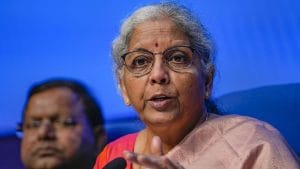






 Listen to the Article
Listen to the Article  Daily Newsletter
Daily Newsletter





